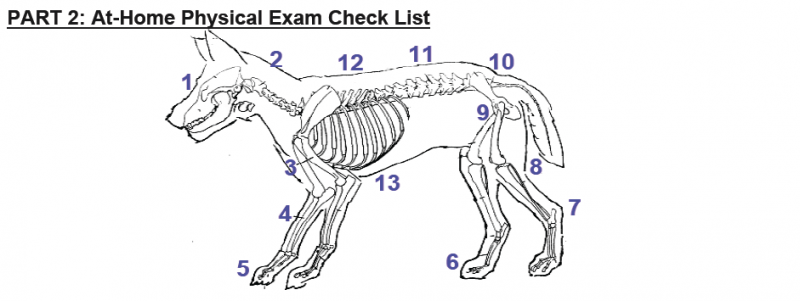How to Conduct an At-Home Physical Exam (Video)
We all know that our pets need to have veterinary physical examination at least once or twice a year. Conducting at-home physical examinations does not replace a professional veterinary examination. It is meant to complement this veterinary visit, add more structure, help with accuracy and increase appointment flow during the visit.
Every vet knows that the most important part of your pet’s vet visit is the annual/bi-annual consultation and physical examination. Because our pets do not speak words to us, an important component of your pet’s physical examination is what you, the guardian noticed (both subjective and objective) in your pet over the year. The health of your pet depends not only between you and your pet, but also between you, your pet and your family veterinarian. This is called the guardian-pet-veterinarian relationship. My hope is that this talk will help strengthen this bond and in so doing, allow for more accurate understanding of issues that may need to be addressed to ensure your pets stays happy and healthy.
An at-home pet examination is conducted monthly by you and is an easy tool to provide you with a more objective approach to the progress of at-home care of your pet. The importance of this examination is at least 3-fold:
1) It helps to make the best use of your usually 15-20 minute annual veterinary visit—you will have an outline of questions/concerns you have noted in your pet over the year that you can have your family veterinarian address at the appointment. A good understanding of your pet’s health can depend on how you’re your family veterinarian can understand your description of your pet’s problems.
2) 1 year in our pet’s years is approximately 7 years in our human years, this is an oversimplified calculation, but the point is, if you can conduct a pet examination ONCE a month, you will be able to pickup subtle changes that may warrant veterinarian attention sooner than the 6 month or yearly examination.
3) It will help you develop a stronger bond with your pet as you will be able to pickup and notify any subtle changes in their behavior/emotional state, daily routine and changes to their physical bodies that may guide your veterinarian to investigate further during their vet visit.
At-home pet examinations are easy to do and although we may not have fancy equipment, we can utilize our own human senses as well as other home tools to help us get a cursory understanding of our pet’s health status.
The pet examination is divided into two parts: The first part entails assessing our pet’s emotional state or daily routine and our pet’s gait or movement through observation. The second part of the pet examination entails more a hands-on evaluation and using other senses besides observation such as touching, smelling and listening. Both parts of this examination are equally important.
Getting Started:
This is Roly and he is going to be our demonstration kitty for this talk. When conducting your monthly examination on your pet, pick a time and place that is relaxed for both you and your pet—especially for the second part of the examination where you will need to handle your pet. So for example, if you have a rambunctious puppy, it may be best to conduct an examination in a quiet room and after the puppy has been tuckered out from play.
**Part I: Starting with the first part of the pet examination:
MENTATION/EMOTIONAL STATE/DAILY ROUTINE: As all other days, Roly is bright, happy and alert today. Relaxed at the moment, but did not deviate from his regular routine licking and patting my face at 4:30am this morning, eating his food, defecating and urinating. I know that when Roly eats, he will always leave a few bites of his food in his bowl for a later snack and that he poops and urinates at least once every 12 hours.
GAIT/MOVEMENT: Roly was very active since this morning at 4:30 am. No difficulty in jumping up onto his favourite spot on a high shelf in my bathroom or onto by bed and has been racing around. I did not notice him limping.
**Part II: This is the hands-on part of the examination and we will start at the tip of Roly’s nose end at the tip of his tail. You can use the printable PDF version of our body chart at www.tomobilevet.com/blog to document any changes you may need to bring up to your family veterinarian. At your pet’s vet visit, bring your filled out body chart to your veterinarian to review. Guaranteed, your vet will be impressed with how organized you are with any questions/concerns that you would like he/she to address!!
HEAD AND FACE:
Starting with the head and face, look at your pets eyes make sure they are both opened up equally, no squinting and the pupils are symmetrical (cats have vertical shaped pupils, dogs’ are round and similar to ours) there is no eye discharge. Abnormal yellow or green discharge could signify an infection. Squinting could signify pain or discomfort of the eye. You can also pull back the eyelid (dogs and cats have very movable skin so this does not hurt them) to visualize the sclera, the white portion of our and their eyes to make sure it is not red or appears irritated. While manipulating with their eyelids, if a slightly pinkish membrane starts to cover the eye, do not be alarmed, cats and dogs have a modified caruncle the red prominence we have at the inner corner of our eyes. Cats and dogs have it modified so it acts as a third eyelid. This should not normally be up. If it stays covering the eye, there may be concern for illness.
Next look at the nose—any discharge? There should be none. The nose can be slightly moist to dry depending on the time of day, but it should never appear cracked or have anything dripping or clogging from the nostrils. Roly’s natural nose colour is pink and it is pink today and appears clean and dry.
Next look into each ear and see if it is clean and free of discharge or scabs from scratching. Smell the ear to ensure there is no malodour.
Looking inside your pet’s mouth—it’s a good idea to learn how to do this. For kittens and puppies, this is an opportune time to get them trained and used to you handling their mouths, but for our adult pets who are not used to this handling, take it slow as they may find it offensive if you force open their mouths if they are not used to you doing this. A way to start is to give them plenty of cheek and chin rubs. Eventually rubbing the outside of their teeth and gums with your finger. Again the pet skin is very loose so you can pull back the lips quite far to visualize the teeth and gums. So you can pull their cheeks right back to see the molars and premolars. When I am doing this I am checking that Roly’s gums are a nice healthy pink colour, there is no redness signifying inflammation of the gums, there is no bleeding or abnormal bumps in the mouth. The teeth should be white, browning of the teeth could signify tartar (calcified plaque) buildup. If your pet is comfortable with this step, you can next try to open their mouth (again you may need to take this part slow and try at a later time). Place your index and thumb just behind their upper canine teeth and applying firm but gentle pressure, then take your free hand and with your index finger gently pull down the lower jaw by pushing down on the lower incisors. You may have to try this several times and/or on different occasions before your pet is comfortable with this step, but you eventually want to be able to look inside the mouth, back of the throat and on the tongue to see if there are any abnormal growths, bleeding gums. The tongue roof of the mouth gums should all be pink. Smell the breath and ensure there is no foul odour
NECK AND THROAT:
Gently massage the throat region and under the chin on either side paying attention to any bumps or scabs or sores in this area. Cats and dogs also have an “Adam’s Apple” so gently feeling a small hardened bump over the throat like ours is normal.
FORELIMBS AND FINGERS:
Pet over the neck and shoulders and then down each of the forearms. Take a look at the nails. Press down on each of the toes and look at the nails. You are checking to ensure there are no nails that need trimming or evidence that they are curling in towards the toe pads that could cause potential problems in the future such as ingrown nails, infection and pain. The average cat has 5 fingers on the forepaws. The average dog has 4 fingers (there can be 5 if there are dew claws—the thumbs), but some of them may still have dewclaws which are the thumbs.
BACK:
Massage gently over the back and along each side of the spine. Your pets should enjoy this. Anytime you feel there is muscle tension or if there is whimpering or growling from your pet, this may suggest your pet is uncomfortable in this area and you should take note of this and seek veterinary assistance if you feel this cannot wait for their yearly checkup.
ABDOMEN/BELLY: Gently massage over the back and then down towards the abdomen where this should feel soft and supple. Almost like a water balloon that is partly filled with water. Not rock hard or tense. There should not be signs of discomfort yelping or growling when touched in this area. The abdomen generally covers the area behind the rib cage and in front of the hind legs.
HINDLIMBS AND TOES: Continue your gentle massage over the hips and down to the hind toes. Again, press down on each of the toes and look at the nails. You are checking to ensure there are no nails that need trimming or evidence that they are curling in towards the toe pads that could cause potential problems in the future such as ingrown nails, infection and pain.
The average cat has four toes. The average dog has 4 toes (there can also be 5 if there are dew claws the big toes), but some of them may still have dewclaws which are the thumbs.
TAIL/REAR: Stroke the tail from the base to the tip making sure you do not feel any lumps or bumps or scratches that you may need to take note of.
SKIN/COAT: Finally, look through the fur (starting from the head and working to the tail) by combing the fur backwards in general spots, looking to see the skin underneath. The skin should not appear red or flaky. There should not be any specks of dirt and should be clean. The fur coat should be shiny and smooth with minimal odour.
Don’t forget to reward your pet with a treat, kisses or extra pats and words of love at the end of their examination.
If you would like to schedule a phone consult with me regarding this topic, please visit the Toronto Mobile Veterinary Services website at www.tomobilevet.com and book online.
View below or click here for a downloadable .PDF (124KB)
Have a wonderful day


Maggie and Michael - July 7, 2014 5:07 pm
Very informative Dr. Tina.